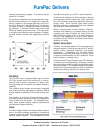
Today's IAQ Challenges
The effort to increase performance and efficiency of
buildings has resulted in tighter construction and
reduced air infiltration. Airborne particulate and gas
phase contaminants released from paint, carpeting,
wallpaper, insulation, copy machines, and cleaning
agents become trapped in the work environment.
A typical ventilation system recirculates 80-90% of the
total air volume in the building, and introduces 10-20%
outside (make-up) air to the recirculated air, in order to
dilute the airborne contaminants and reduce stale-
ness. However, make-up air often introduces new
pollutants to the building, such as diesel and gasoline
engine exhaust, mold, pollen, dust, offensive odors
and other common outdoor pollutants.
The key to providing healthy indoor air is reducing the
levels of airborne particulate and gas phase contami-
nants. A successful ventilation system reduces the
levels of contaminants through high efficiency filtration
and gas phase control, while at the same time, reduc-
ing maintenance, upkeep, and operating costs.
Filtration System Considerations
PurePac's particle collection efficiency is continuous
and not highly dependent on particle size or filter load-
ing, therefore actual efficiencies of 90-95% and high-
er can be achieved at an economical operating cost.
PurePac is available with optional TechSorb HMZD
impregnated bonded carbon panels for gas phase
contaminant and odor control. The rigid panels elimi-
nate air by-pass, channeling and settling, which are
typical with conventional loose granular carbon filters.
The disposable HMZD panels also offer clean, easy,
removal and replacement.
The operating cost to move ventilation air through a fil-
tration system is directly related to the filter is resist-
ance. PurePac's low and constant 0.25î w.g. resist-
ance results in reduced fan horsepower and a signifi-
cant energy savings compared to conventional filtra-
tion. Since PurePac's efficiency is instant and contin-
uous, fouling of heating and cooling coils is reduced,
resulting in higher performance and reduced operat-
ing cost of the system.
PurePac incorporates a permanent self-cleaning sys-
tem, eliminating the replacement and labor cost of
buying, changing, and disposing of filters. A life cycle
cost analysis almost always shows that PurePac's
performance and reliability can be justified.
Today’s Solution
PurePac is designed to work in conjunction with a
building’s air handling units and ventilation systems,
delivering the specified level of efficiency, continuous-
ly and reliably.
High reliability, optimum performance, and low operat-
ing cost make PurePac the IDEAL SOLUTION for
today’s indoor air quality challenges.
Performance
PurePac uses a 2-stage electronic collector for partic-
ulate control. A high-density, low power first stage
charges each particle. The charged particles then
travel downstream into the second stage where they
are repelled from the air stream, captured, and
retained on collector plates.
The electronic collector uses an airfoil design that
eliminates air-bypass, so all of the HVAC system air
and airborne particulate pass directly through the
Flanders Precisionaire - Foremost in Air Filtration
Engineered Products: 1-800-637-2803 Replacement Products: 1-800-347-2220










